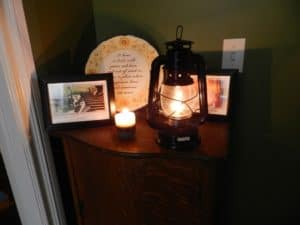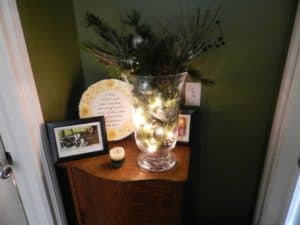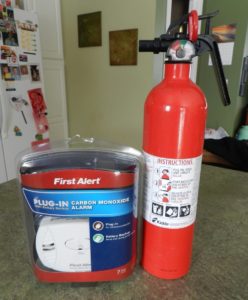The most obvious thing that we all miss during a power outage is lighting-on-demand. We really have no idea how much we take this convenience of the last century for granted until we are in the middle of a power outage and keep flicking the light switch every time that we enter a new room. We’ve all been there!
If you’re new to preparing for power outages, or if you find yourself in the middle of one right now and want to be better prepared the next time around, it might seem like a pretty easy problem to solve, right? Just some candles, and a flashlight and I’m good to go!
Not exactly the case. There are pros and cons to everything, and I’m going to go over some of them with you now.
The best lighting in a power outage is lighting that does not endanger the occupant of the household with excessive heat or flame, it does not threaten the air supply within the home with lethal or noxious gases, and is efficient with the power needed to supply the light.
How can we power lights?
There are essentially two ways: By flame (candle, lantern), or by electricity (in the form of a generator, battery backup system, solar charged items with a battery, or small AA/AAA batteries for devices).
Flame: Wax, Oil, fuel of some sort
The oldest and simplest method of providing light and heat as a by-product would be an open flame. This can be driven by wax candle, oil or some sort of fuel for a lantern device. These are tried and true methods for providing light, and when the flame is a reasonable size, the risk of hurting the occupants within the house with harmful gases is minimal provided that your dwelling is reasonably ventilated or you take steps to make it that way.

So why wouldn’t we want to stick with this method that’s been around for millennia?
The saying, “you’re playing with fire” couldn’t be any more real here. Not only that, you’re playing with fire in a situation where you can’t necessarily see everything, your mind is stressed from dealing with the power outage and upset kids, and you’ve got a dozen other things on your mind that need to get done — like how are you going to save the food in your refrigerator!
One careless bump of a lantern by you or a child, or setting a candle around something that it shouldn’t be around could mean the end of your daily home-ownership troubles!
I once had an apartment and some of the decor was given to me by the previous tenant. They had a ceramic wide-mouth vase that I would place a small, lit tea-light candle in without even thinking about it because it would make a cool effect on the wall and ceiling when the lights were low. I did this for months without issue.
One day, I came into the room and found that the glaze on the vase had finally decided it was time to combust, and I had a 2-3’ flame like the Statue of Liberty jutting out of the vase along the wall and onto my bookshelf!
Throwing water into the vase only made it splash wax, paints, and glaze and I received a heck of a burn along my entire right arm. Smothering the vase with a pot ultimately saved the day, but not without some property damage. I can only imagine if I had not returned to that room for even 2 more minutes!
I have learned my lesson, and in retrospect, it was a very stupid place to keep a candle. Now, I keep candles and I have two oil lanterns in my garage for absolute backup, but the blackout would have to last probably a month before I would even consider dealing with them. The risk versus the reward is just not there in my opinion — especially with small children in the home.
Electricity
Generator
The most common way we think of to power our lights during a power outage is a generator. These can range anywhere from $100 – $10,000 and anything in between. They might run on gasoline, propane, or be converted over the natural gas.
Though they are the most popular, they are the noisiest option and the most inefficient option in my opinion if you’re just looking for lighting. Unless you’re running spotlights or high operation grow lights, you will never tax your generator for its energy even on idle when it is running and you’ve got every light on in the house.
If we’re looking to just power the lights and not much else, a generator is effective but inefficient and you are trading gasoline for lights at a bad exchange rate. If you typically only experience power outages for a few hours to a day, then it probably isn’t a big deal to run the generator to supply lighting. At night though, is when it can get a little tricky due to noise complaints by neighbors and thieves out looking for a new generator.
Battery backup system
The most efficient way to reasonably light up the house and make it safe and comfortable is with a battery backup system. It will only give out the amount of power that you require of it. It does not burn gas unnecessarily just by idling. Plus, they are silent so you can run them in the evening without bothering the neighbors, and you can charge them during the day when you run the generator!
Even a single 100 amp hour marine battery would get you around 24 hours of continuous use if you were to run 10 x 5-watt LED lights nonstop before the battery was fully discharged. Cut the number of lights in half, and you’re looking at 48 hours. Assuming you only run the lights 6 hours a day during the evenings, you’ve got a lot of lighting time.
Despite being incredibly efficient, they are not without drawbacks. If you store them inside, you have to be very careful about how you charge and the environment that you keep your battery in. Near a pilot light is a bad idea. Using a charger that has an automatic desulfation mode is a bad idea since (without your knowing) it causes your battery to heat up during the process and vents hydrogen gas along with other foul-smelling gases.
I currently have a set-up inside my home with two golf-cart batteries and 215 amp hours, but I have a charger and maintainer that I trust, it is away from open flame, and my charger/maintainer will not desulfate my battery.
Despite me trusting my charger, I have been experimenting with getting into the habit of not charging/maintaining the batteries on a constant basis, but rather plugging the charger in once every couple days to keep things topped off. Healthy batteries will have a very low self-discharge in normal temperatures so I won’t be losing hardly any energy by them sitting without a charger for a few days (weeks even!).
By doing this I reduce the risk of my battery venting gases if my charger were to malfunction.
You can read my stance on battery safety with regards to hydrogen gas at the bottom of my article about battery chargers in my article here.
Car battery with a power inverter
A 12-volt car battery paired with a DC/AC power inverter is another way to supply electricity to your items. With some extension cords, you can run lamps, charge your devices, and even your battery charger for your AA and AAA batteries which you will then use to make more light!
If you are on a budget, buying a power inverter to pair with your car is a fantastic investment. I recommend that everyone have one. I use mine more when on long road trips than anything else, but they have saved my bacon during my first few power outages before I saved up for a generator and dedicated battery bank backup system.
You can check out my article for a complete look at how to power your devices and lights from your car battery here.
Batteries for devices
The most common option available to most people, especially if you haven’t taken any steps to prepare are normal AA and AAA batteries to power some flashlights and other battery-operated candling devices. This should be the first base that you cover and I suggest finding flashlights that have LED bulbs (for efficiency and effectiveness) and that only require a single battery (to conserve the amount that you have). You can check out my recommended lighting resources page here for my favorite indoor lighting options during a power outage.
I highly recommend getting several dozen AA and AAA rechargeable batteries, a good charger, and a DC/AC power inverter so that you can have an unlimited supply of batteries during your a power outage, as long as you have a car and fuel to run it.

I have a resources page link here to my favorite rechargeable batteries and charger, as well as a link to my article about why rechargeable batteries are a better choice.
Lightbulb selection: Why LED lights win over other types?
I recommend using LED lights for not only my everyday use but especially for power outages for the following reasons:
- Affordable and everywhere
- You can find LED flashlights very cheaply and they are widely available and nearly any retail store.
- LED light bulbs are still typically more expensive than incandescent and CFL bulbs, but only by a couple dollars in my experience. Considering their lifespan (below), it’s a “no-brainer”!
- Durable and robust
- You might bust the bulb of an LED light but it will still work. The bulb is just for effect and for light dispersion. Incandescent and CFL lights would immediately cease to work if you broke the bulb.
- Energy Efficient
- I stock up on 5.5 watt LED bulbs in “daylight” texture that give me what a standard 60 watt light bulb would emit. Remember the example above about the marine battery? 10 of these 5.5 watt light bulbs would last over 21 hours. A single 60-watt incandescent bulb would last for 20 continuous hours. I’ll leave it to you to decide which is a better buy when you’re trying to conserve energy.
- Safety
- CFL lights contain mercury inside and if broken that mercury now becomes a hazard. Plus, even if you don’t break them, you need to make sure to dispose of them properly when they burn out since we don’t want mercury leaking on the way to or in the landfill.
- Lifespan
- LED lights last far longer than any incandescent or CFL lightbulb. It’s not even in the same ballpark. 25,000 hours for an LED, 8,000 hours for a CFL, and 1200 hours for an incandescent.
- Cheaper to operate
- Since they draw fewer watts and provide the same, if not more light, they cost less on your electric bill.
- Temperature considerations
- LED’s do not get too hot to touch during operation and are not sensitive to cold temperatures.
Methods of lighting the house during a power outage
Lamps (or your normal lights)
As we mentioned up top, if you have a generator, a battery backup system or a power inverter with our car battery, you are fully capable of powering lamps or normal lights (with a generator and transfer-switch).
Flashlights/Lanterns for Portable use
As I mentioned above, having a solid LED flashlight that uses a single battery is a great investment for every member of your family. It gives everyone that personal companion to light up anything they might need — from reading under the covers to trying to set up the generator outside in the dark. It is great to have a trusty flashlight for everyone, and if you find a good deal on a set of cheap LED flashlights, just toss them in drawers around the house! They might break easier, but you’ll thank yourself later when beggars can’t be choosers.
I have a link here to my favorite lighting solutions for power outages if you’d like to check it out.
Glow sticks
These are not necessarily effective in my opinion for giving off working light, but when you have kids these can make a power outage a lot more fun and adventurous! It’s honestly worth the investment in my opinion of a pack or two of these to just have at the ready. Kids can wear them as jewelry, and walk around the house like glowing orbs when everyone is stressed. It definitely lightens the mood and keeps them happy.
Battery Operated Christmas lights
If you’ve got a lot of batteries on hand, an easy way to give navigational light throughout a room is to pick up a string or two of lights after the holidays that only require AA batteries to operate. You can easily string them along a ceiling with some small, screw-in C-hooks. If you leave them up they will hardly be noticeable. The downside with these types of lights is that they are prone to malfunctioning.

Solar for indoor and out
Often solar lighting is overlooked as an indoor solution. I certainly think that having a few solar, outdoor, motion-detection flood lights are a great idea for home security. Driveway, backyard, and front door are great areas to cover. This is especially important if you plan on running your generator when it is dark — not only for you to be able to see, but to deter thieves. These lights have great reviews and are very affordable on Amazon if you’d like to take a peak.
While I don’t feel that the typical outdoor solar lights that you’d find along a garden walkway offer very good lighting for indoor applications, it can certainly serve in the “nightlight” capacity. Even the simple stick-in-the-ground lights can be brought in at night and placed strategically throughout the house and restrooms to give navigational light.
Candles, oil lanterns, and open flames
We’ve already covered this and the answer is NO! — unless there is literally no other option, and you have a fire extinguisher and battery backup carbon monoxide detectors on hand.
Certainly be sure to ventilate your house occasionally if you use a fair amount of open flame, and I would recommend ventilating immediately before going to sleep (since carbon monoxide puts you to sleep anyways and you never wake up).
NEVER USE AN OPEN FLAME WHILE YOU ARE SLEEPING OR OUT OF THE ROOM! Bad things happen to good people when you do that!

My favorite tip on how to light my house for night time security
During the evening when we are trying to live as normal as possible considering the fact that the power is out, we need to keep in mind that darkness is the best friend of those who have ill intent. When we go to bed, it is normally dark, but lights are always on demand.
How can we achieve lighting our entire house in an instant during a power outage in case we think someone is breaking into our home?
I have a dedicated battery backup system in my basement, but you could achieve the same results if you were to bring your car battery inside. You’ll just need the battery, a DC/AC power inverter, a power strip, extension cords, splitters (to run cords in multiple directions), and lights.
Simply hook the inverter up to the battery and run whatever cord is necessary from the inverter to get to the side of your bed. Have it then plug into a surge protector strip that has the power on/off switch that usually lights up red.
Now, you run an extension cord from the surge protector strip and have it go throughout the house with splitters to reach the different lights and lamps in the home. Turn all of the lights on.
As you get in bed, just turn the surge protector off and all of the lights will go off as well. If you hear something that startles you when the whole neighborhood is in darkness, just flip the switch and your entire house will light up. It is sure to surprise someone who expects the power to be out!
Conclusion
In the order of operations, I recommend that you get the flashlight and batteries (rechargeable preferably) out of the way. After that, a DC/AC power inverter of 400-800 watts would be an excellent investment. Beyond that, you can’t go wrong with a small generator or a small battery backup system if you’re so inclined. The important thing is to take some sort of action now while the lights are up and working. As the old saying goes, “proper preparation prevents poor performance.” I might have left out a choice word or two, but you get the idea!


